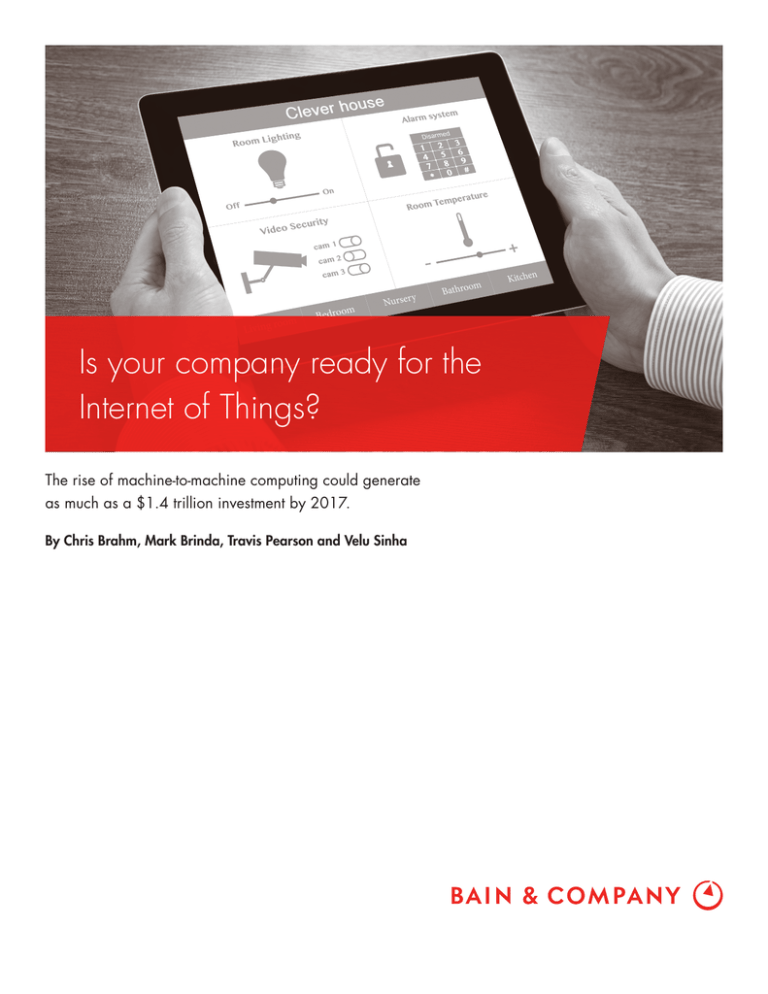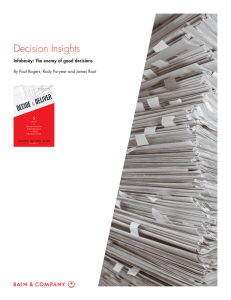
Is your company ready for the
Internet of Things?
The rise of machine-to-machine computing could generate
as much as a $1.4 trillion investment by 2017.
By Chris Brahm, Mark Brinda, Travis Pearson and Velu Sinha
Chris Brahm and Travis Pearson are partners with Bain & Company in San
Francisco. Mark Brinda is a Bain partner in New York, and Velu Sinha is a
partner in Bain’s Palo Alto office. All four work with the firm’s Technology
practice in North America, which Travis leads.
Copyright © 2014 Bain & Company, Inc. All rights reserved.
Is your company ready for the Internet of Things?
Intelligent cars that drive and park themselves. Retail
systems that watch where shoppers linger. Home thermostats that detect the owner’s arrival and turn up the
heat. In some ways, the future is already here: each of
these applications is already up and running, a part of
the Internet of Things. What’s changing quickly is the
universality of them, the integration and communication among systems like these to create a new paradigm
of pervasive computing.
All of this activity will generate tremendous opportunity
across many industries. Direct investment in hardware, software and solutions could top $70 billion by
2017, and the related opportunities are much greater—
perhaps as much as $1.4 trillion (see Figure 1). Google’s
purchase of Nest for $3.2 billion in January 2014 indicates
some of the enthusiasm for connected products and
services that appeal to customers.
Some industries are already using pervasive computing
at scale. Utilities are investing significantly in smart grids,
smart meters and smart thermostats, encouraged by
regulators and enabled by established standards. In
healthcare, on the other hand, privacy concerns and
industry fragmentation create barriers to unlocking
new value from pervasive computing solutions.
Which companies will provide the hardware, software
and services that make these scenarios extensive and
real? If the past is an indicator, they may not be the
same companies providing them today. We see pervasive computing as a major architectural shift. As in
previous shifts, we expect to see the leaderboard reshuffled. The winners in pervasive computing will develop
high-value, repeatable solutions at the intersection
of mobility, analytics and cloud computing, creating
new sources of value from the explosion of data that
surrounds us.
As with other architectural shifts, we expect the first
comprehensive solutions to be designed for specific
industries. That focus will allow developers and designers
to work within a limited construct of requirements to
Figure 1: While direct spending on hardware, software and services could top $70 billion, related opportunities
in pervasive computing could reach $1.4 trillion by 2017
Estimated global opportunity by 2017
Total~$1.4 trillion
Data analytics~$50 billion
Big data infrastructure, services and software, business intelligence, data integration and advanced analytics
Software
and services
Service revenue for communication service providers~$355 billion
Connectivity services
Software and applications~$180 billion
Enterprise application software, software-as-a-service, other services
Network
equiptment
Network equipment~$45 billion
Enterprise network equipment
Business and operations support systems~$65 billion
External OSS, BSS, service-delivery platforms (SDP)
Hardware/
devices
Core machineto-machine
(M2M) services
and modules
Tablets~$130 billion
Smartphones~$470 billion
Custom apps and services
~$26 billion
Package apps
~$11 billion
Sensor devices~$55 billion
RFID, sensor terminal board,
telepresence / teleconference
development
Connectivity
~$14 billion
Infrastructure hardware Hardware modules
~$15 billion
~$2 billion
Sources: IDATE; IDC; IDTechEx; IHL Group; Gartner; Ovum; Operator M2M Strategy Update 2012; Wall Street research; Bain analysis
1
Point-of-sale
equipment
~$2 billion
Mobile POS
Is your company ready for the Internet of Things?
solve the complex problems of association and management across multiple layers and thousands of devices.
Many components already exist, but the cost and complexity of integrating them into a complete solution
remains expensive. Companies that can create affordable, end-to-end offerings will make it easier for others
to invest in the next wave of computing. Over time,
we’ll see platforms emerge within sectors, followed by
cross-industry solutions.
As these platforms emerge, the companies creating
pervasive computing solutions will need to overcome
several hurdles. At the infrastructure and database layers,
they will need to learn how to manage the interaction
of millions of sensors and find ways to cost-effectively
collect and analyze the huge volumes of unstructured
data they produce. In development, new platforms
geared specifically for machine-to-machine applications,
like Salesforce1 and GE’s Predix, are just beginning to
scale up.
•
Where does the value lie: in hardware (advanced
servers, new chips), in software and services, or in
the data itself?
•
Which solutions will meet customer needs and
offer a compelling case for investment? Which will
reduce costs, generate revenue and lower risk?
•
What capabilities and assets do we need to develop
and deliver these solutions? Who should we partner
with, up or down the stack?
•
Which standards should we back?
•
What are the risks of not acting?
The next three to five years will be critical as pervasive
computing moves into the mainstream and the number
of connected devices and related applications skyrockets.
Executives across industries, but especially in the technology industries that will enable this shift, should focus
on answering the critical questions today that will
position them for leadership tomorrow.
All of these issues will lead to rich discussions as senior
executives plan their pervasive computing strategies.
Among the questions they should be asking:
2
Shared Ambition, True Results
Bain & Company is the management consulting firm that the world’s business leaders come
to when they want results.
Bain advises clients on strategy, operations, technology, organization, private equity and mergers and acquisitions.
We develop practical, customized insights that clients act on and transfer skills that make change stick. Founded
in 1973, Bain has 50 offices in 32 countries, and our deep expertise and client roster cross every industry and
economic sector. Our clients have outperformed the stock market 4 to 1.
What sets us apart
We believe a consulting firm should be more than an adviser. So we put ourselves in our clients’ shoes, selling
outcomes, not projects. We align our incentives with our clients’ by linking our fees to their results and collaborate
to unlock the full potential of their business. Our Results Delivery® process builds our clients’ capabilities, and
our True North values mean we do the right thing for our clients, people and communities—always.
Key contacts in Bain’s Technology practice:
Americas: Chris Brahm in San Francisco (chris.brahm@bain.com)
Mark Brinda in New York (mark.brinda@bain.com)
George Cogan in Silicon Valley (george.cogan@bain.com)
Dianne Ledingham in Boston (dianne.ledingham@bain.com)
Travis Pearson in San Francisco (travis.pearson@bain.com)
Velu Sinha in Silicon Valley (velu.sinha@bain.com) Paul Smith in Silicon Valley (paul.smith@bain.com)
Rasmus Wegener in Atlanta (rasmus.wegener@bain.com)
Asia-Pacific:
Florian Hoppe in Singapore (florian.hoppe@bain.com)
Kevin Meehan in Singapore (kevin.meehan@bain.com)
Charlie Ormiston in Singapore (charlie.ormiston@bain.com)
Moonsup Shin in Seoul (moonsup.shin@bain.com)
Europe,
Middle East
and Africa:
Stephen Bertrand in London (stephen.bertrand@bain.com)
Fred Debruyne in Brussels (frederic.debruyne@bain.com)
Hans Joachim Heider in Munich (hans-joachim.heider@bain.com)
For more information, visit www.bain.com









